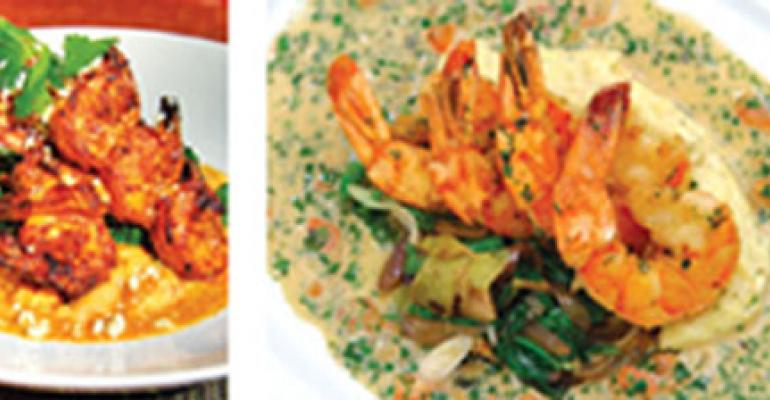Singular or plural? Milk or water? Southern culinary cliché or regional American delicacy? There’s very little agreement about grits, except among chefs, who seem to agree that the corn-based dish is an excellent palette for a wide variety of dishes.
Chefs around the country are putting their own twists on the classic combinations, including shrimp and grits and cheese grits, while also sourcing a higher-quality, stone-ground product.
Grits, which are simply coarse ground corn, are available in mass-marketed varieties, but there also has been a resurgence in stone-ground grits made from heirloom varieties of dent corn, as opposed to table corn. Those varieties offer a fresher, “cornier” flavor and a pleasing texture, experts say. Stone-ground grits must be eaten freshly ground or stored in the refrigerator or freezer. The oil in the germ deteriorates quickly at room temperature.
John Martin Taylor, whose firm Hoppin’ John’s sells grits ground by a mill in Georgia, tells of moving back to Charleston, S.C., from Europe in 1986 and not being able to find the kind of country, stone-ground grits he grew up with.
“Not a single restaurant in Charleston,” he says, “had grits on the menu.”
After an extensive search, Taylor located a young couple in Georgia who not only grew heirloom varieties of dent corn but who were restoring an old mill to grind it in. Dazzled by the fresh corn taste of the just-ground grits, he began selling them in his bookstore and eventually became the mill’s exclusive representative, writing about them in Gourmet and the New York Times and supplying them to restaurants nationwide.
Similarly, Glen Roberts, who worked for many years as an architectural restoration consultant, became interested in the history of Southern food and concerned that many of the best were no longer available. He began to seek out the varieties of heirloom corn that made the best grits and cornmeal, and in 1998 he founded Anson Mills. He began selling to chefs in the Carolinas and Georgia, but before long, he had a national clientele that included some of the best-known chefs in the country.
Traditionally, grits were simply cooked in water and served with butter, although some chefs prefer to cook them in cream or stock.
“I put nothing in them,” says Roberts. “I want to taste the corn.” When cooking grits at home, he often uses a slow cooker set on low and cooks them overnight.
Despite the minor differences in preparation, there’s little dispute about the fact that grits pair well with shrimp, and that classic combination appears on menus nationwide.
Taylor credits the popularity of shrimp and grits partly to Bill Neal, whose book, “Bill Neal’s Southern Cooking,” published in 1985, contained the recipe for the shrimp and grits he had been serving in his restaurant, Crook’s Corner in Chapel Hill, N.C. In the book, Neal called his version of deep-fried shrimp with brown onions and grits “a Carolina dish.”
Now the dish can be found on menus of restaurants as far from the South as Jimmy’s 43 in New York City and Moondance in Malibu, Calif.
Shrimp and grits, which have been on the menu of Vidalia in Washington, D.C., since its opening, have become a signature dish. Chef de cuisine R.J. Cooper, who buys his grits from Anson Mills, mixes the finest and the coarsest grind of grits to achieve a combination of creaminess and texture, then he cooks the grits in milk.
Grits pair well with other dairy products as well, and butter is the topping of choice in most of the South. Indeed, chef Bob Kinkead of Kinkead’s in Washington, D.C., says one of the chief virtues of grits is “their ability to soak up massive quantities of butter.”
Chefs are also putting their twists on cheese grits, another Southern standard. While cheddar is the traditional cheese of choice, chefs have experimented with other varieties. Tory McPhail at Commander’s Palace in New Orleans serves his New Orleans barbecued shrimp with stone-ground grits flavored with Brie. B. Smith’s at Union Station in Washington, D.C., uses smoked cheddar for its shrimp and grits.
Chefs have discovered that the fresh-corn flavor of stone-ground grits combines particularly well with Mexican food, which has a corn tradition that predates the Western discovery of it. At DC Coast in Washington the lunch menu includes grilled chipotle-spiced shrimp with creamy Mexican chorizo grits, sautéed spinach and queso fresco.
Carolina chef Louis Osteen’s menu at Louis’s Las Vegas includes a veal chop accompanied with grits pudding with roasted poblano chiles and white cheddar. Bobby Flay’s Mesa Grill in New York serves an appetizer of creamy wild-mushroom grits with a poached egg, a serrano-chile sauce, cotija cheese and blue-corn tortilla crisps.
Grits also make a complementary side dish, chefs say. In New Orleans and New Orleans-style restaurants, grits are popular with grillades, or thin, pounded slices of veal or beef cooked in a rich brown gravy. At Cochon in New Orleans, chef Donald Link serves onion-braised pork cheeks with grits and a horseradish-herb vinaigrette. At San Francisco’s Elite Café, slow-roasted pulled pork is served with roasted garlic grits. At Smoke Modern Barbecue in Basalt, Colo., grits accompany wild salmon.




